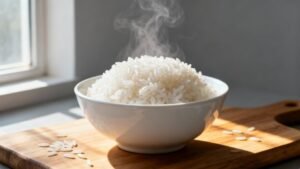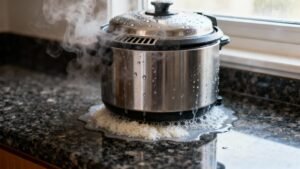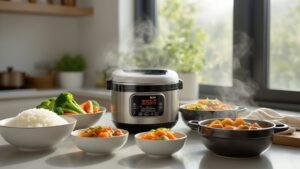Picture your rice cooker as a pressure valve that’s lost its cool—when steam can’t escape properly, you’re looking at a kitchen mess that’ll have you questioning your cooking skills. We’ve all been there, watching helplessly as starchy water bubbles over the sides like an angry volcano. The culprit? Usually it’s something simple with the steam vent system that most people overlook. But here’s what we’ve learned about stopping this chaos before it starts.
Table of Contents
ToggleUnderstanding Steam Vent Components and Their Critical Role
When we’re dealing with rice cooker problems, it’s easy to overlook the small components that actually make the biggest difference. The steam vent system isn’t just one piece—it’s actually three parts working together like a well-oiled machine. You’ve got the steam vent itself, the steam vent cap that sits on top, and the receptacle that holds everything in place. Think of the steam vent cap as your rice cooker’s pressure valve. When it’s missing or damaged, well, that’s when things get messy. Finding quality replacement parts can be tricky, but it’s worth the effort. Properly rinsing rice before cooking can also help ensure that the rice doesn’t stick and create excess steam, leading to sticky rice issues.
Common Causes of Rice Cooker Overflow and Boiling Over
Five main culprits are usually behind those frustrating rice cooker overflows that leave us cleaning sticky messes off our countertops. When we’re dealing with overflow issues, it’s probably one of these problems causing the chaos.
The most common causes we’ve encountered include:
- Excess starch buildup – unwashed rice creates foam bubbles that steam pushes everywhere
- Overfilled rice cooker – cramming too much rice beyond capacity limits spells disaster
- Clogged steam vent – blocked vents trap moisture and pressure, forcing spillovers
- Wrong water ratios – too much water confuses sensors and disrupts cooking cycles
- Improper rice washing – washing rice before cooking removes excess starch, which helps prevent boil-over.
Understanding these triggers helps us prevent future kitchen catastrophes.
Proper Rice Preparation to Prevent Starchy Steam Buildup
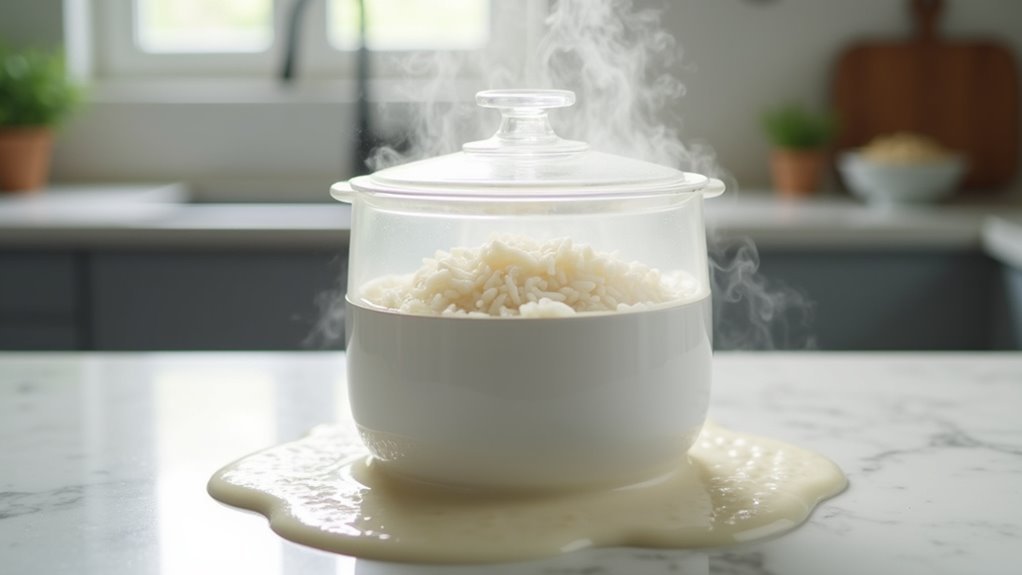
We’ve found that the secret to preventing those annoying steam vent problems actually starts way before you even turn on your rice cooker – it’s all about how we prep the rice itself. When we don’t rinse our rice properly, all that excess starch creates this foamy, bubbly mess that’s basically guaranteed to cause overflow issues. Let’s walk through the essential steps of rinsing rice multiple times, removing that troublesome starch, and stopping foamy steam formation before it even starts. Additionally, using the correct water-to-rice ratio is essential for achieving perfectly cooked brown rice and avoiding overflow problems.
Rinse Rice Multiple Times
Although many of us think we can just dump rice straight into the cooker, proper rinsing is actually the game-changer that’ll save you from those annoying steam vent clogs and messy overflows. Rinsing rice removes excess starch that creates those big bubbles causing chaos in your cooker.
Here’s why we should always rinse:
- No more sticky messes – Clean water means no starchy steam buildup
- Better texture – Your rice won’t clump together like cement
- Enhanced flavor – Removes that cloudy, starchy taste
- Easier cleanup – Less scrubbing afterward
When cooking rice, rinse 3-4 times until water runs clear. Additionally, soaking rice in water for 30 minutes before cooking can further improve desired consistency and texture.
Remove Excess Starch Properly
Now that we’re rinsing our rice, let’s talk about actually getting that starch off properly – and honestly, there’s a bit more to it than just a quick splash under the faucet. We need to remove excess starch systematically to prevent those annoying steam vent clogs.
Soaking brown rice can improve its texture and release additional enzymes, making it easier to digest.
| Rice Type | Rinse Time | Water Clarity Goal |
|---|---|---|
| White Rice | 30-45 seconds | Nearly clear |
| Brown Rice | 20-30 seconds | Slightly cloudy |
| Jasmine Rice | 45-60 seconds | Crystal clear |
Getting our water ratio right means we’re washing rice every grain until that cloudy, starchy water runs clear.
Prevent Foamy Steam Formation
Once that starch removal is handled, we’re dealing with what I’d call the “bubble trouble” – that foamy, starchy steam that loves to clog up our vents and create a real mess. Even after rinsing rice properly, we need to tackle the steam formation itself.
Here’s what actually works:
- Use your rice measuring cup correctly – overfilling creates excess steam pressure
- Start with boiling water, then reduce heat to prevent aggressive bubbling
- Check that your steam vent cap is properly positioned before cooking
- Place a tea towel under the lid to absorb moisture buildup
These steps prevent that troublesome foamy steam formation. Additionally, paying close attention during the cooking process can help avoid overcooked rice and the associated steam issues.
Steam Vent Cleaning and Maintenance Techniques
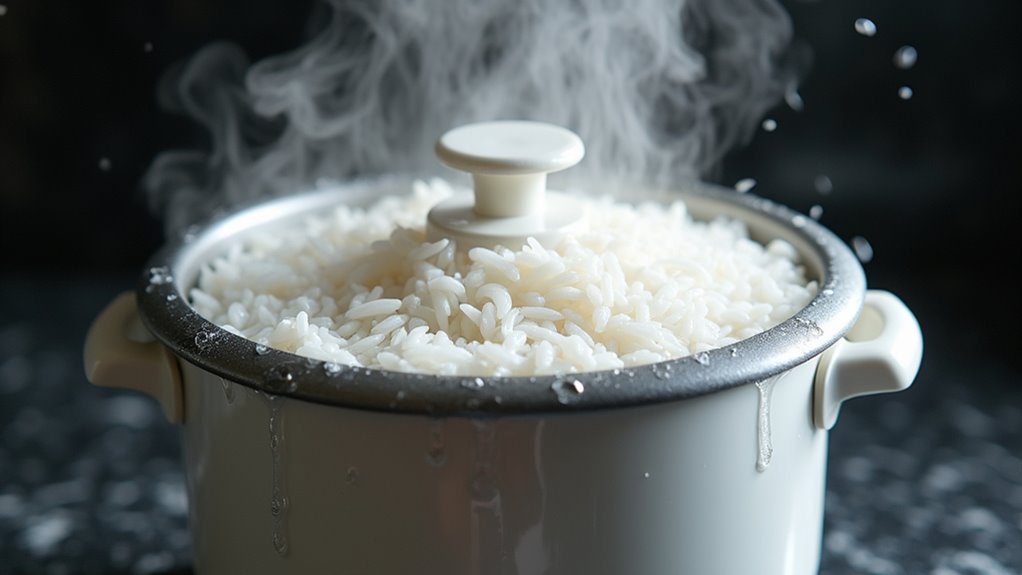
Proper maintenance of your rice cooker’s steam vent system is honestly one of those things that’ll make or break your cooking experience – well, maybe that’s a bit dramatic, but you know what I mean. We need to clean the inner lid regularly with mild detergent and a soft sponge. Don’t put it in the dishwasher – trust me on this one. The steam vent cap should be rinsed under running water to prevent blockages. Check for debris buildup and verify everything’s completely dry before reassembling. If gaskets look worn, grab a replacement part from the manufacturer. Additionally, using a vinegar solution can help remove unpleasant odors and maintain freshness in the steam vent area.
Troubleshooting Water Ratio and Capacity Problems
When we’re dealing with steam vent problems, it’s often not just about the vent itself—actually, let me rephrase that—the real culprit is usually getting our water ratios wrong or cramming too much rice into the cooker. We’ve found that exceeding the maximum capacity creates a domino effect where steam can’t escape properly, and using incorrect rice-to-water ratios makes everything bubble over like a science experiment gone wrong. You know what’s really frustrating though? When your rice cooker switches to warm mode way too early because it thinks the rice is done, but really it’s just responding to all that excess steam buildup. Additionally, remember that brown rice requires more water compared to white rice, so adjust your ratios accordingly to prevent spills.
Correct Rice Water Ratios
Getting the rice-to-water ratio wrong is probably the number one reason we see steam vent problems in Aroma rice cookers. When we don’t follow the correct rice water ratios, we’re basically setting ourselves up for overflow disasters. The amount of water matters more than you’d think – it’s like the difference between a gentle simmer and a volcanic eruption.
Here’s what happens when rice and water ratios go wrong:
- Excess water creates aggressive bubbling that overwhelms your steam vents
- Too little water triggers premature switching to warm mode
- Incorrect measurements lead to starchy, messy overflows everywhere
- Your cooker works harder than necessary and may get damaged
Always use that measuring cup! Additionally, using the wrong type of rice can further complicate the rice-to-water ratio and lead to cooking mishaps.
Maximum Capacity Limits
Most Aroma rice cooker disasters we’ve seen actually come down to one simple mistake – cramming too much rice into a cooker that’s already saying “no thanks.” It’s like trying to stuff a sleeping bag back into its case; you might get it to fit, but it’s not going to end well. When you exceed maximum capacity, water runs everywhere and clogs your steam vent. Check your manual – maybe it’s two cups, maybe four. Don’t push it. We’ve learned that respecting these limits prevents those messy kitchen situations nobody wants to clean up. Additionally, rice cookers are energy-efficient and can help reduce overall energy consumption in the kitchen.
Early Warm Mode Issues
Since your Aroma rice cooker keeps jumping to Warm mode before your rice is actually done, you’re probably dealing with a ratio problem that’s confusing the heck out of the internal sensors. These early warm mode issues happen when we mess up the basics.
Here’s what’s likely going wrong:
- You’re cramming too much rice in there, overwhelming the poor thing
- Water levels are off because you’re eyeballing instead of measuring properly
- That 180mL measuring cup is sitting unused while you wing it
- The cooking process gets disrupted when there’s not the right amount of rice
When to Replace Steam Vent Parts and Gaskets
While we’d all love our rice cookers to last forever, the reality is that steam vent parts and gaskets don’t have infinite lifespans—they’re actually some of the hardest-working components in your machine. We recommend replacing your steam vent cap when you notice cracks, warping, or if it’s missing entirely. Gaskets should be swapped out when they’re no longer sealing properly—you’ll know because steam escapes where it shouldn’t. Don’t wait until replacement becomes urgent. Hand wash these components gently, and honestly, keeping spare parts on hand isn’t a bad idea for consistent cooking results.
Frequently Asked Questions
Why Is My Rice Cooker Bubbling Through the Steam Vent?
Your rice cooker’s bubbling because there’s excess starch creating foam. We’ll fix this by rinsing rice until water runs clear, checking water ratios, and adjusting cooking times for better rice texture.
How to Stop Rice Cooker From Overflowing?
We’ll prevent overflow by using proper cooking ratios for different rice types, rinsing rice beforehand, and following maintenance tips like checking steam vents and not overfilling the cooker.
How to Clean a Steam Vent on a Rice Cooker?
Like clearing a clogged chimney, we’ll unplug the cooker, remove the steam vent cap, wash it thoroughly, wipe the receptacle clean, and brush away blockages—essential cleaning techniques for proper rice cooker maintenance.
Why Does My Rice Keep Boiling Over?
We’ll find your rice boils over because different rice types need specific cooking ratios and moisture levels. Too much water, excess starch, or blocked steam vents cause bubbling that overflows your cooker.



